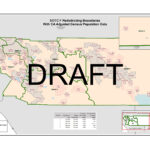
Photo courtesy of Tom Lynch, Idyllwild Water District
The Idyllwild Water District will consider a 50 percent increase in sewer rates at a future meeting, probably in September. The district’s sewer system and wastewater plan were built in 1971 and have been in use since 1972. Much of pipeline has reached its normal life expectancy and replacement is needed in several locations, said General Manager Tom Lynch.
A possible increase for stand-by fees may be proposed later this year, but Lynch plans more investigation of that initiative before it goes before the board.
At a workshop Wednesday, July 9, Lynch presented the history of the sewer program’s finances, a current assessment of its condition and photos of the worst problems. Lynch concluded with several options for increasing the current usage rate.
The staff initially proposed a 100 percent rate increase, but the committee, composed of directors Warren Monroe and John Cook, is recommending a 50 percent rate increase, according to Lynch. This proposal would raise the current monthly rate of $25.50 by $12.75. The new monthly rate would be $38.25.
The sewer revenue, exclusive of property tax assessments assigned to the sewer program, is estimated to reach $360,000 in 2014-15 and would grow by $180,000 to nearly $540,000 annually with the proposed increase.
The costs of the sewer program have increased about 21 percent over the last 10 years to a total of about $460,000 annually, which is about $100,000 more than the fees collected from sewer customers. With the addition of property tax revenue, the net loss in 2013-14 was $2,600. But the cumulative loss, over the same 10-year period is nearly $140,000.
The sewer program’s direct revenues do not cover its costs, Lynch showed the board. “The operating expenditures exceed the sewer revenue. That’s the problem,” Lynch said.
Further, these are operational costs, without including any capital improvement expenses. Since 2008, IWD has not pursued any major maintenance work. During the period, capital investment in the sewer program has come from the district’s reserves, Lynch informed the board.
But new investment is needed now, Lynch said. Planning for some major sewer program capital investment, Lynch is encouraging the board to raise the rates in order to improve the program’s self-sufficiency and to protect the district’s reserves.
Lynch is proposing a $2.2 million sewer capital program over the next five years. The 2014-15 portion would be about $530,000 and the final $300,000 in 2018-19. Even with the addition of the proposed revenue increase (about $180,000 annually), the district will still have to use reserve funds to pay the full cost of the improvements, Lynch told the board.
“The capital needs far exceed the program’s revenue and we’ll still use reserves,” he said.
The most expensive project is a tertiary treatment facility, costing about $900,000. Repairing and replacing the 1-mile effluent line between the sewer plant and the settling ponds will cost about $500,000 and is scheduled to begin this fiscal year.
“This line is deteriorated and is at risk of failure,” Lynch said. “The last mile between the plant and ponds is disintegrating. How serious? Very serious!”
The pipeline is more than 40 years old and is beyond the ability of the district to reweld it, Lynch confirmed to the board. While the district normally does a video inspection of the sewer pipeline system every 10 years, Lynch indicated that pipeline in this area is too fragile to accommodate the video equipment.
“The rest of the pipeline is generally in good condition,” Lynch said. “It has been only 8 years since our last inspection.”
“This is a pretty well-defined problem,” said director Dean Lattin, “but a problem that needs to be acted on urgently.”
Before Lynch brings the rate increase to the board for a decision he wants to mail a letter of notification to sewer customers 45 days in advance of the meeting.










